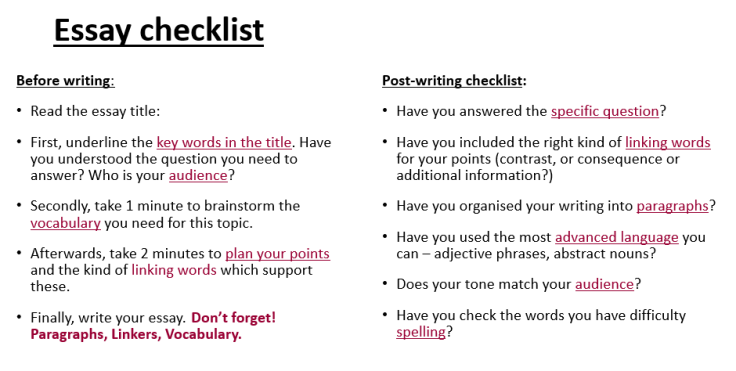Ever wondered what EAL is? I have found out it’s a bit like a cousin of ELT – they’ve got a lot in common, but aren’t quite the same. Here’s what I’ve discovered so far after a couple of months in EAL and this post is as much as about me getting it all straight in my head than anything else!
The students:
I work in an international school, so the local community language is not English. The students I teach might not integrate easily into the local school system for cultural or linguistic reasons, e.g. Russian or Chinese kids who move around the world every couple of years as their parents’ jobs demand. The majority however, are from the local community, looking to improve their future success and entry to Oxbridge, or even further afield, by studying in an English curricular context. All of the classes in the school (apart from modern languages obviously) are taught in English. Students are assessed as they apply to the school to see whether they need any English support to help them to access the curriculum and that’s where I come in.
If students are evaluated as needing support, then they are timetabled in with me in small groups, defined by their school year. I can see some students for several hours a week, while others only need one, but this time is adjusted as progress is made. My biggest group at the minute has 6 students in it, which is about half of what I used to teach and has meant some re-adjustment for planning activities and timing! I also spend time with these students in their English Literature classes mostly carrying out a kind of ‘real-time’ scaffolding – breaking down instructions, mapping vocabulary or prompting correct grammar use.
The content:
This is the biggest difference of all. I support learners whose English level is an obstacle to accessing the curriculum fully in class. This could mean I need to help them hone skills for essay writing or reading academic texts, or there could be a need to increase relevant, subject-specific vocabulary (geography, or science, or Shakespeare!) and, of course, work on grammar to help sentence structure and guarantee clear communication.

I have to say this is one area where I’ve had a bit of difficulty at times. I do have resources to work from, but have made the decision to integrate graded readers, or a selection of authentic texts and branch out into relevant areas for their subjects across the curriculum. For example, I am currently working on an Artic-themed module, including geography (environment, climate and movement of people), biology ( Flora and fauna – polar bears and sea otters) and other subject links. This has meant working with subject teachers to identify what the curriculum covers and finding resources to fit, which has been a bit time consuming, but wonderful too.
Another example is what I did with one Year 7 student –  we decided to read The Secret Garden which led to working on describing the life cycle of a plant, a poster project on the Japanese activity of Forest Bathing and it’s biological benefits, as well as planning a garden for all seasons.
we decided to read The Secret Garden which led to working on describing the life cycle of a plant, a poster project on the Japanese activity of Forest Bathing and it’s biological benefits, as well as planning a garden for all seasons.
I also teach my own class who are preparing for the IGCSE in ESL as an alternative to a language and literature-based IGCSE. It’s more familiar, a kind of exam-prep course which seems to be somewhere between FCE grammar and CAE vocabulary demands, with a lot more specific reading and writing skills, such as summarising, note-taking and essay writing. The themes are familiar ones for a ELT context – the environment, entertainment etc. – but I used to have to focus a lot of time on speaking skills (as my students had little opportunity to practise) and now, in my EAL context, these kids can chat to you about just about anything and speak English all day, so the focus os more on reading and writing skills, academic texts and appropriate register.

As well as all the EAL work, I also do a bit of SEN support, but it’s not a lot this term. I love this part of the job because it’s mostly with primary school children, so I get to use all my little YL exprience and it adds rewarding variety to the week! What’s interesting is how so much of good ELT training is applicable to SEN support – scaffolding skills and learning strategies have all been essential skills I’ve ‘brought over’ from my ELT training.
The Timetable:
I love my new timetable. Having gone from a half-management position I teach way more than I have done for the past year or two, but I have always loved being in the classroom and this was never going to be an issue. I used to start my day early, most of my lessons were around 3pm or 5 pm and I often worked through till 7pm, occasionally till 8pm. I also worked Saturdays for a very many years. Now I finish work at 3.30pm. It’s daylight. There is regular public transport. I get to spend dinner time with my kids. I never work Saturdays. It’s the ‘little’ things that count.

The future:
It’s been a really refreshing change for me and I am weirdly enjoying being brand new and having little challenges like not knowing where to get paper clips from or knowing how to use the different photocopiers, as well as making small talk with new colleagues. I do miss my old staffroom though. There was a great, collaborative culture for planning (kind of the happy result of not having enough space) and often just good chats about what we do. Teachers in this school plan from their own classrooms and most of us teach at the same time, so it’s harder to see how that spontaneous collaboration could happen. I need to find the edugeeks!
So, EAL is new enough, but not completely different to what I did before. One thing more I will add – I don’t think I’d want to be a newly-trained teacher going into a context like this – I think good EAL teachers need to have enough experience and knowledge about language to make snap decisions, pull out resources and activities quickly and direct this (very personalised) learning experience for the students efficiently. The class periods are much shorter than what I was used to (sometimes not even an hour), so it’s sometimes hard to focus on an achievable, concrete learning aims in such a short space of time.

All things considered, anyone who enjoys teaching motivated teens, and enjoys deconstructing subject content to make it more accessible, who is comfortable working in a classroom alongside other teachers and at making lightning-quick decisions about how to adapt any classroom language (at any time) would love it as much as I do already. I love the variety, the challenge and the reward at seeing how fast these kids progress in their language-rich environment. #EALrocks
Helen
This work is licensed under a Creative Commons Attribution-NonCommercial 4.0 International License
Leave a comment